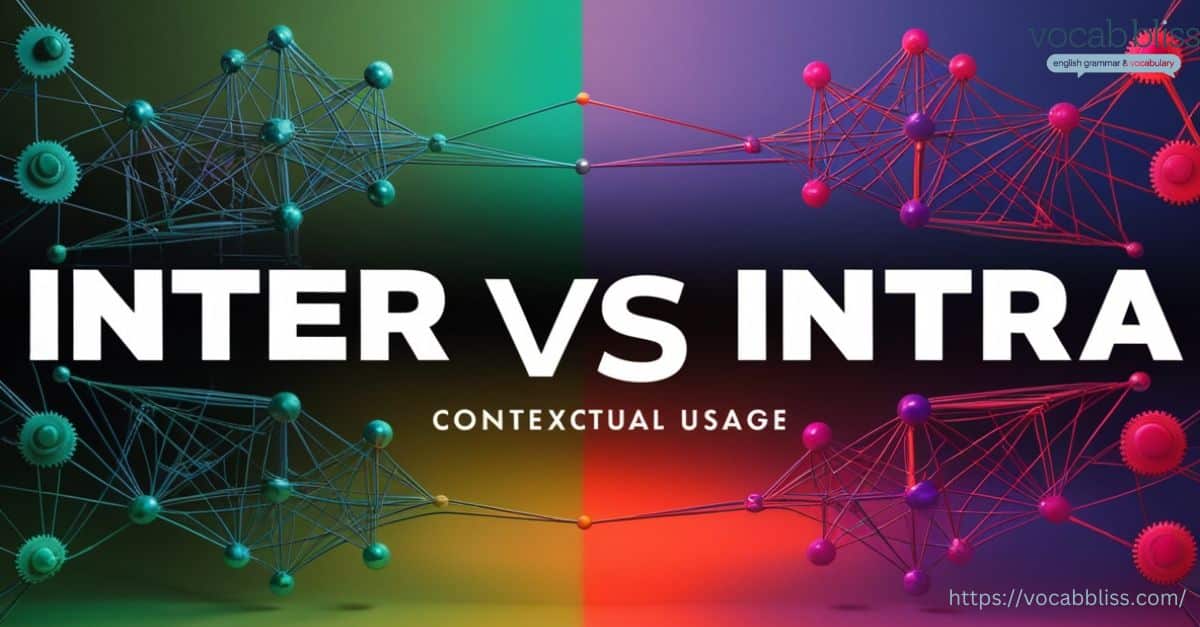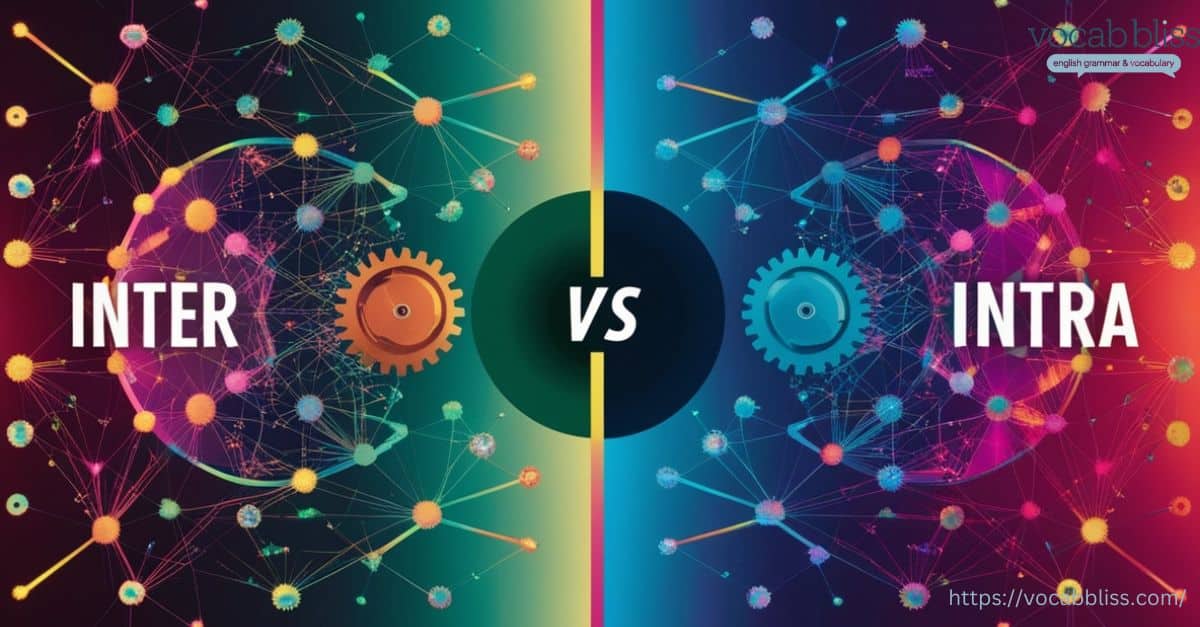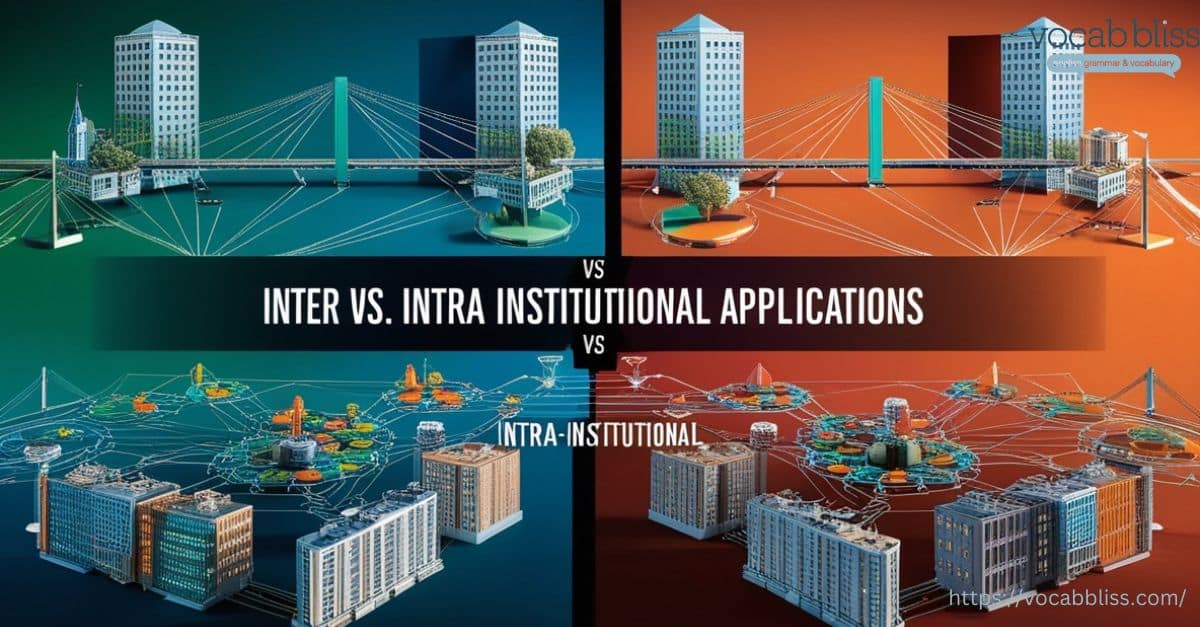Language is a fascinating tool for communication, and prefixes like Inter vs Intra add layers of meaning to words. Despite their small size, these prefixes significantly influence the context and understanding of terms they precede. This guide dives deep into the difference between inter and intra by first exploring their definitions, then providing examples, and finally examining their practical applications.
To begin with, let’s uncover the meanings behind Inter vs Intra, explore their Latin roots, and examine their relevance in various contexts. By doing so, we can better understand how these prefixes shape the words we use every day.
Quick Summary
“Inter” and “intra” are prefixes that indicate different types of relationships. Inter means “between” or “among” and is used for connections between separate entities, such as in inter-school competitions or inter-company collaborations. Intra, on the other hand, means “within” and is used for activities or processes inside a single entity, like intra-school events or intra-departmental meetings. Understanding these prefixes not only helps clarify communication in various fields like business, academia, and medicine but also ensures the correct usage in different contexts.
Read More: Is It Fourty or Forty? Which One Is Accurate?
Understanding “Inter vs Intra”
The Essence of Inter
The prefix inter finds its roots in the Latin word inter, meaning “between” or “among.” In essence, it conveys the idea of connections or interactions that occur across boundaries or between multiple entities.
For instance, words like “international” and “interact” illustrate how this prefix emphasizes relationships spanning different regions or individuals.
Key Examples of “Inter”:
- International: Relating to or involving two or more nations.
- Interdependent: Mutual reliance between entities.
- Interpersonal: Interactions or relationships between people.
This prefix is commonly used when describing relationships, exchanges, or activities that span different groups or spaces.
Intra Unveiled
Similarly, the prefix intra originates from the Latin word intra, which translates to “within” or “inside.” It emphasizes containment or processes that are confined within a single entity or boundary.
Key Examples of “Intra”:
- Intranet: A private, internal network restricted to members of an organization.
- Intramural: Activities or competitions occurring within one institution, such as sports within a single school.
- Intravenous: Administered directly into a vein.
Unlike inter, which connects external entities, intra highlights internal or self-contained processes.
Distinguishing the Two Inter vs Intra
A clear comparison helps differentiate these prefixes Intra vs Inter
| Aspect | Inter | Intra |
|---|---|---|
| Root Meaning | Between, among | Within, inside |
| Scope | External, spanning multiple groups | Internal, confined to one group |
| Common Uses | International, interdependent | Intranet, intramural |
Visual Representation:
Venn Diagram:
- Inter (Outer Circle): Connections between groups or entities.
- Intra (Inner Circle): Processes within a single group or entity.
- Overlap: Highlights situations where both prefixes might be applied in layered contexts, such as inter-institutional collaboration within an intranet.
Inter vs Intra Contextual Usage

Business Context
In the corporate world, the prefixes inter vs intra play a significant role in defining the scope of activities or communications. For instance, they influence how organizations operate and, more importantly, how they interact with others.
Specifically, understanding the distinction can clarify whether processes are happening within a single entity or between multiple entities. Therefore, mastering these prefixes is essential for clear and effective communication in professional settings.
Inter in Business:
The prefix inter, therefore, in a business context, denotes relationships, projects, or collaborations that involve multiple organizations or entities. For instance, terms like interagency or interorganizational highlight cooperative efforts spanning different groups. Examples include:
- Inter-agency meetings: Discussions between different government departments or companies.
- Inter-company partnerships: Collaborations between separate businesses to achieve common goals.
- Inter-branch communication: Coordination between various locations of the same company.
These instances, therefore, showcase how inter facilitates external exchanges that expand the organization’s reach and capabilities. Moreover, such collaborations often lead to innovative solutions and shared expertise.
Intra in Business:
On the other hand, intra focuses on internal operations or activities within a single organization. Examples include:
- Intra-departmental communication: Sharing information among members of the same team or department.
- Intra-office memos: Internal messages circulated within a single office or branch.
- Intranet usage: A private, secure network for employees to access internal resources.
The use of intra ensures efficient internal communication, streamlined processes, and organizational coherence.
Academic Setting
In academia, Intra vs Inter play vital roles in describing collaboration, research, and activities at various levels.
Inter in Academia:
The prefix inter is used to describe programs or initiatives that involve collaboration between multiple institutions or fields of study. For example, interdisciplinary research combines insights from various academic areas to address complex problems. Similarly, interinstitutional programs foster partnerships that enhance resources and broaden impact. Examples include:
- Interdisciplinary studies: Programs that integrate knowledge from different academic fields, such as bioinformatics (biology + informatics).
- Inter-university exchange programs: Partnerships allowing students or faculty to study or teach across universities.
- Inter-departmental seminars: Academic discussions bridging separate disciplines, like engineering and economics.
Intra in Academia:
The prefix intra applies to activities or events that occur within a single institution or field of study. Examples include:
- Intra-school competitions: Debates, sports, or academic contests held within one school or college.
- Intra-departmental research: Projects conducted by members of the same academic department.
- Intra-university events: Activities exclusive to one university’s faculty or students.
These distinctions between Intra vs Inter reflect their scope and application in both educational and professional contexts.
Communication Dynamics
Inter-organizational Communication
Inter-organizational communication refers to the flow of information between different organizations or entities. In particular, this type of communication often facilitates partnerships, outsourcing arrangements, or joint ventures. By fostering clear and efficient exchanges, it enables entities to collaborate effectively and achieve shared goals. Furthermore, it plays a crucial role in building trust and aligning strategies across organizations..
Key Examples of Inter-organizational Communication:
- Partnership discussions: Negotiations between two companies to form strategic alliances.
- Outsourcing agreements: Communication between a business and its external vendors or service providers.
- Joint venture planning: Collaborative efforts involving multiple organizations to create new products or enter new markets.
- Industry forums: Events where organizations discuss shared challenges and opportunities.
Effective inter-organizational communication relies on clarity and mutual understanding, therefore ensuring successful collaborations that benefit all parties involved.
Intra-organizational Communication
Intra-organizational communication takes place within the boundaries of a single organization. It involves the exchange of information, updates, or feedback among employees, teams, or departments, which promotes efficiency and alignment with the organization’s goals.
Key Examples of Intra-organizational Communication:
- Employee updates: Internal newsletters, announcements, or memos to keep staff informed.
- Team meetings: Regular gatherings for project updates, brainstorming, or problem-solving within a department.
- Internal feedback systems: Surveys or platforms that allow employees to share their insights.
- Training sessions: Workshops or e-learning modules provided exclusively to internal staff.
Strong intra-organizational communication, therefore, fosters a cohesive workplace, resulting in reduced misunderstandings and enhanced productivity.
Both Inter vs Intra communication are critical to organizational success, with their distinct scopes addressing different needs. While inter expands an organization’s reach externally, intra ensures smooth internal operations.
Inter vs Intra Relationship Structures

Inter-personal Relationships
Inter-personal relationships refer to the interactions and connections formed between two or more individuals. These relationships can take various forms, such as friendships, familial ties, professional connections, or even brief exchanges with strangers. The prefix inter here emphasizes the external nature of these interactions.
Key Examples of Inter-personal Relationships:
- Friendships: Emotional bonds developed through mutual interests and trust.
- Professional networking: Building relationships for career development or business opportunities.
- Team collaborations: Working together to achieve common goals.
- Conflict resolution: Addressing and resolving differences between individuals.
Inter-personal relationships are foundational to human experience, fostering communication, cooperation, and social bonds.
Intra-personal Processes
In contrast, intra-personal processes occur within an individual’s mind or self. These internal dynamics, including thoughts, emotions, self-awareness, and decision-making, shape how a person perceives and interacts with the world.
Key Examples of Intra-personal Processes:
- Self-reflection: Examining one’s thoughts, actions, or emotions to gain insight and improve behavior.
- Decision-making: Analyzing choices and determining the best course of action.
- Emotional regulation: Managing internal feelings to maintain composure and adapt to situations.
- Goal-setting: Planning and prioritizing personal objectives.
While inter-personal relationships connect individuals to others, intra-personal processes focus on self-understanding and personal growth. Inter vs Intra Both are crucial for a balanced and fulfilling life, highlighting the external and internal dynamics of human interaction.
Inter vs Intra Institutional Applications

Inter-institutional Collaborations
Inter-institutional collaborations involve partnerships or cooperative efforts between separate institutions. These collaborations, in particular, aim to address shared goals, leverage collective expertise, or solve large-scale issues that require combined resources. The prefix inter underscores the connection between entities working together.
Examples of Inter-institutional Collaborations:
- Intergovernmental agreements: Treaties or pacts between nations, such as climate change accords.
- University partnerships: Joint research projects or exchange programs between institutions of higher learning.
- Healthcare collaborations: Coordination between hospitals or research centers to tackle global health crises.
- Business coalitions: Industry-wide partnerships to establish standards or drive innovation.
Case Study: United Nations Collaborations
The United Nations (UN) exemplifies inter-institutional collaboration. By partnering with various governments, NGOs, and academic institutions, the UN addresses global issues like poverty, education, and environmental sustainability. Programs such as the UN Sustainable Development Goals (SDGs) demonstrate how inter-institutional cooperation can lead to impactful outcomes on a global scale.
Intra-institutional Initiatives
Intra-institutional initiatives focus on efforts within a single institution. These activities, therefore, aim to improve internal processes, enhance efficiency, and promote collaboration among departments or teams. The prefix intra highlights the contained, internal nature of these endeavors.
Examples of Intra-institutional Initiatives:
- Intra-hospital training programs: Workshops or seminars for staff to improve patient care and streamline procedures.
- School improvement plans: Efforts to enhance teaching methods or infrastructure within one school.
- Corporate wellness programs: Internal activities to boost employee health and morale.
- University research projects: Investigations conducted entirely within a single institution.
Practical Applications
In Technology
- Inter: Refers to interconnected systems like the Internet, which spans globally.
- Intra: Focuses on private networks like intranets, accessible only within an organization.
In Medicine
- Inter: Interactions between organs, such as intercellular communication.
- Intra: Refers to processes occurring within a single organ, like intravenous medication.
In Psychology
- Inter: Social dynamics and relationships.
- Intra: Mental processes within an individual, such as introspection.
Linguistic Nuances

Compound Words
Prefixes like Inter vs Intra are integral to forming compound words. For example:
- Interconnected: Suggests a network of linked systems.
- Intracellular: Indicates processes within cells.
In Different Languages
Both prefixes are widely used across languages, often maintaining their Latin roots. For example:
- In Spanish, inter- is used in internacional.
- In Italian, intra- appears in intraprendere.
Inter vs Intra Common Questions Answered
What’s the difference between inter- vs intra-?
Inter means “between,” while intra means “within.” This simple distinction changes the scope of their application.
When should you use inter- vs intra-?
Use inter for actions or connections spanning multiple entities, while intra is used for those confined within one entity.
Is a hyphen required when using inter- or intra- prefixes?
In modern usage, hyphens are typically unnecessary unless clarity demands it (e.g., “inter-city bus” for emphasis).
Intra school competition meaning?
An intra-school competition refers to events or contests held within a single school, where only its students participate.
Intra college meaning?
Intra-college refers to activities, events, or competitions that take place within a single college involving its students or staff.
Inter- vs Intra- Examples
To better understand the distinctions between inter- vs. intra-, let’s explore real-life examples across various contexts. These examples demonstrate how these prefixes apply in diverse fields, showcasing their distinct inter- vs. intra- meanings.
Examples Across Contexts
Business
- Inter: Inter-company meetings (collaborations between different companies).
- Intra: Intra-departmental memos (communication within one department).
Academia
- Inter: Interdisciplinary programs (combining different academic fields).
- Intra: Intra-school activities (competitions within the same school).
Medicine
- Inter: Inter-hospital transfers (patient moved between hospitals).
- Intra: Intra-arterial injections (administered within an artery).
Communication
- Inter: Intercontinental calls (calls made between different continents).
- Intra: Intranet systems (networks within one organization).
Inter- vs Intra Side-by-Side Comparison
Here’s a clear table that contrasts inter and intra in different contexts:
| Context | Inter (Between/Among) | Intra (Within) |
|---|---|---|
| Business | Inter-company partnerships | Intra-office emails |
| Academia | Inter-university collaborations | Intra-class projects |
| Medicine | Inter-department patient referrals | Intra-muscular injections |
| Technology | Inter-network connections | Intranet for employees |
| Sports | Inter-state championships | Intra-team training sessions |
| Government | Inter-governmental treaties | Intra-agency policy reviews |
Key Takeaway
The distinction lies in scope:
- Inter operates across different entities or groups (external).
- Intra focuses on internal processes or activities within a single entity.
Conclusion
Understanding the difference between Inter vs Intra is essential for clear and effective communication. By recognizing whether a context involves connections between groups (inter) or within a single group (intra), you can confidently choose the right prefix.
Prefixes like these enrich language, offering precision and depth to our expressions. Next time you encounter a word with inter or intra, consider its scope and context for a clearer understanding.
Continue reading:
- Inbetween or In Between? Which Is Correct?
- Pick Up or Pickup, Pick-Up: How Should It Be Used?
- Infact or In Fact: What’s Grammatically Correct?”
- Lead or LEED: When to Use Which One?

Jorge Phillips is an experienced blogger who writes for Vocab Bliss, sharing his passion for the English language. With a knack for simplifying complex grammar rules and a focus on commonly confused words, Jorge helps readers navigate the nuances of English with ease. His insights aim to make learning engaging and practical.







